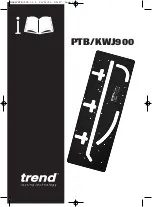
6-711A
2
Rev. 09/09/19
WARNING
FAILURE TO OBSERVE THESE WARNINGS COULD RE SULT IN IN JU RY.
• Do not remove any labels. Replace damaged
labels.
• Do not lock, tape or wire the "on/off"
safety lever in the "on" position, as the
lever must be free to return to the "off"
position when released.
• Failure to heed these warnings may reusult
in personal injury and/or property damage.
WARNING: This product can
expose
you to chemicals including
nickel which is known to the State of
California to cause cancer and birth defects or
other reproductive harm. For more information
go to www.P65Warnings.ca.gov.
THIS INSTRUCTION MANUAL
CONTAINS IMPORTANT SAFETY
INFORMATION.
READ THIS INSTRUCTION MANUAL
CAREFULLY AND UNDERSTAND ALL
INFORMATION BEFORE OPERATING THIS
TOOL.
• Read and understand all instructions.
Failure to follow all instructions listed below,
may result in electric shock, fire, explosion
and/or serious personal injury. It is the
responsibility of the owner to make sure all
personnel read this manual prior to using
the device. It is also the responsibility of the
device owner to keep this manual intact and in
a convenient location for all to see and read.
If the manual or product labels are lost or not
legible, contact NAPA for replacements. If the
operator is not fluent in English, the product
and safety instructions shall be read and
discussed with the operator in the operator's
native language by the purchaser/owner or
his designee, making sure that the operator
comprehends its contents.
• Always operate, inspect and maintain
this tool inaccordance with American
National Standards Institute Safety Code of
Portable Air Tools (ANSI B186.1) and any
other applicable safety codes and
regulations.
• For safety, top performance and
maximum durability of parts,
operate this tool at 90 psig; 6.2
bar max air pressure with 3/8"
diameter air supply hose.
• Always wear impact resistant eye,
face & hand protection (Users
& Bystanders) when operating or
performing maintenance on this
tool
• High sound levels can cause
permanent hearing loss. Always
use hearing protection as
recommended by your employer
an OSHA regulations while using
this tool (users and bystanders).
•
Keep the tool in efficient
operating condition.
• Operators and maintenance personnel
must be physically able to handle the bulk,
weight and power of this tool.
• Air under pressure can cause
severe injury. Never direct air
at yourself or others. Always
turn off the air supply, drain
hose of air pressure and
detach tool from air supply
before installing, removing
or adjusting any accessory
on this tool, or before performing
any maintenance on this tool.
Failure to do so could result in injury. Whip
hoses can cause serious injury. Always check
for damaged, frayed or loose hoses and
fittings, and replace immediately. Do not use
quick detach couplings at tool. See instructions
for correct set-up.
• Keep tool out of reach of children.
• Air powered tools can vibrate
in use. Vibration, repetitive motions or
uncomfortable positions over extended
periods of time may be harmful to your hands
and arms. Discontinue use of tool if discomfort,
tingling feeling o pain occurs. Seek medical
advice before resuming use.
•
Slipping, tripping and
or falling while operating air tools can
be a major cause of serious injury or
death. Be aware of excess hose left on the walking
or work surface.
• Keep body working stance balanced and
firm. Do not overreach when operating the
tool.
• Do not point or indulge in any horseplay with
this tool.
• Anticipate and be alert for sudden changes in
motion during start up and operation of any
power tool.
• Do not carry tool by the hose.
Protect the hose from sharp objects
and heat.
• Cutting with these tools will create
sharp edges. Wear gloves to
protect hands.
• Tool shaft may continue to reciprocate briefly
after throttle is released. Avoid direct contact
with accessorie during and after use. Gloves
will reduce the risk of cuts or burns.
• Cutting edges and blades can
become hot during use. Do not
touch.
• Keep away from reciprocate end
of tool. Do not wea jewelry or loose
clothing. Secure long hair. Scalping
can occur if hair is not kept away
from tool and accessories. Choking can occur
if neckwear is no kept away from tool and
accessories.
• Do not use (or modify) the tool for any other
purpose than that for which it was designed
without consulting the manufacturer's
authorized representative.
•
Never force the cutting tool to cut
faster or through heavier gauge
material than rated capacity.
• Use accessories recommended by
NAPA Tools.
• Do not lu
bri
cate tools with
flam ma ble or vol a tile liq uids such
as ker o sene, die sel or jet fuel.
• This tool is not insulated against
electric shock.
• This tool must not be used in explosive
atmospheres.
• Servicing and repairs should only be made
by an authorized service center.
• Do not force tool beyond its rated capacity.

































